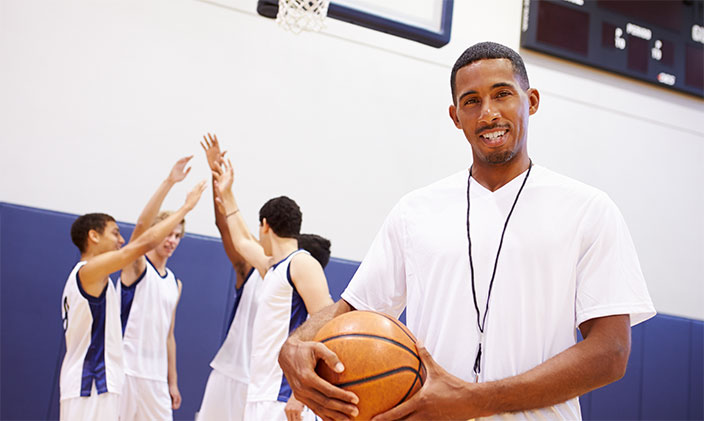Essential skills for online teaching
This article was updated on February 14, 2025.

Written by Michael Feder

Reviewed by Pamela M. Roggeman, EdD, Dean, College of Education

In recent years, we have seen a profound change in the way students learn and teachers teach. The proliferation of digital technologies has set the stage for online colleges and universities, a development that has made education more accessible across the board. It has also helped educators develop skills for online teaching. In this article, we’ll talk about some of the challenges teachers face in virtual learning and the skills that can help overcome them.
Before the pandemic, we were seeing gradual growth of online teaching in schools and universities; the outbreak of COVID-19 only accelerated the process. Lockdowns and social distancing protocols forced students and teachers to adopt new technologies in their learning processes.
At every educational level, students are logging in to online school that would otherwise have been taught in person. A laptop computer, a webcam and a microphone have replaced the blackboard, the pencil and the notebook.
A changing world can bring many benefits and opportunities, particularly in the realm of education. At the same time, the rapid digitization of education has left many teachers and students feeling like something is missing.
The benefits and challenges in online teaching
Five online teaching skills to help students succeed in virtual learning
Exploring the issue of remote education from both the teacher and student perspectives, we’ll discover some essential skills for making virtual learning a success for everyone.
1. Communicate and collaborate
Considering nearly everyone has a phone or other telecommunication device at their disposal, you’d think people would have an easier time communicating. But it’s just not that simple.
Virtual learning presents several technical and psychological challenges that can hinder communication between teachers and students. On a technical level, breakdowns in internet connectivity, communication software and devices can lead to disruptions that make communication difficult.
Here are some tips to improve communication and collaboration skills for online learning:
- Be clear and concise in both verbal and written communication.
- Don’t be afraid to repeat back what you hear someone say to ensure you understand the key takeaways of an exchange.
- Double-check that everyone in your group is on the same page, and leave opportunities for questions.
Here’s why communication and collaboration are important online learning skills for students and teachers.
For teachers:
Many teachers were unprepared for the shift to online teaching. Developing strong communication skills can help make that shift easier.
- Good communication skills can help you empower students to understand and relate to the instruction.
- Students have natural abilities as social learners, and clear communication forms a central part of this learning process.
- By understanding verbal and nonverbal cues, you can better identify when it’s time to change your approach.
How teachers can help students:
- Encouraging communication is central to building and maintaining strong relationships with classmates.
- Creating a back-and-forth dynamic can benefit everyone and help students get the most from their teacher’s instruction.
- Encourage and accept feedback on curriculum and instruction to make better coursework for virtual students.
2. Take the initiative
In traditional, in-person education settings, students and teachers have ample opportunity to interact and fine-tune the overall experience. A student can stay after class to go over homework with an instructor, who may also pull a student aside to have an impromptu chat about how the class is going.
Remote learning reduces opportunities for these kinds of spontaneous interactions that facilitate a successful education. Immediately after class, many students and teachers leave the group call, take off their headphones and slam their laptops shut. That doesn’t do anyone any favors.
- Taking the initiative can help your students look at you as an active and engaging educator.
- Starting conversations with students about their digital education can give you information to improve your curriculum.
How teachers can help students:
- Expressing interest in a student’s perspective or concerns can help position a teacher to identify and capitalize on opportunities to connect and foster communication.
- Taking the initiative to ask that nagging question or express a concern can help solidify an understanding of a concept before the lesson moves on.
- Taking the initiative in the classroom can help develop skills students can use in their career.
Starting these conversations can make the difference for students who may be struggling.
3. Manage time
When students and teachers observe the same schedule in a school or university, literally traveling together from classroom to classroom, it can be easy to manage time over the day. Such consistency benefits both students and teachers.
The advent of online classes and virtual schooling, however, has strained or even obliterated such consistency. A fluid schedule seems appealing at first, allowing students to wake up just a few minutes before class begins or using class time to do outside work. But over time, the lack of consistency can wreak havoc on academic results.
How can students and teachers develop and maintain good time-management habits? Read on.
For teachers:
- Take the time to prep for online teaching.
- Address student needs as they arise.
- Take note of where time is used in virtual settings and adjust lesson plans accordingly.
- Work with students to make the best use of your shared time.
How teachers can help students:
- Suggest an easy-to-follow schedule they can stick to.
- Identify bad study or virtual learning habits and take steps to resolve them.
- Encourage them to use a physical or virtual planner.
- Set up work in digestible chunks, such as is in the Pomodoro method.
4. Establish achievable goals
It might be too much to ask students and teachers to act as if the demands of virtual schooling are the same as those of in-person learning. Many virtual schooling measures were implemented quickly, and they shift responsibility to both students and teachers when it comes to making necessary adjustments. That can be a tall order for someone who finds themselves in an online teaching job.
By that same token, however, this unprecedented time also brings new opportunities for making and reaching educational goals.
While the course material might not necessarily change between physical classrooms and virtual settings, the lesson plans to create strategies and maintain engagement will be very different. When done well, students feel their goals are achievable, and that’s a win for students and teachers alike.
Setting reasonable goals for educational progress offers other benefits too, such as the following.
For teachers:
- Try out a couple of new technologies to see what works for students. The vastness of resources can be overwhelming, but new developments in technology can help meet student needs.
- When students fall short of their goals, it can require additional time and attention that teachers may not have. Alternatively, helping to establish feasible goals keeps everyone on track for success.
- Setting achievable goals can help build trust with students, as they feel that their needs are being heard and addressed.
How teachers can help students:
- Encourage them to only commit to classes and extracurricular activities that they have time for, so they’re more likely to succeed.
- Provide a platform to express any doubts or concerns to help them achieve their goals with less stress.
- Set out on an achievable plan toward educational goals that can help make their path to graduation smoother.
5. Practice patience and flexibility
Being a student or teacher has never been easy. Students are expected to work hard and get good grades while mastering a rigorous curriculum. Teachers are expected to guide students through the curriculum without leaving anyone behind. Taken together, this can require a lot of patience and flexibility from both students and teachers.
Online teaching exacerbates the challenges in this area. Developing patience and flexibility can be crucial online class skills for students and teachers alike as they help make the educational experience much less stressful for both.
Here are some reasons why remaining flexible and patient is important as a student and as a teacher.
For teachers:
- Students may not be enthusiastic about learning new technology skills, requiring teachers to develop patience and communication skills to help them adapt.
- These skills are especially crucial when working with younger students.
- Introduce skills little by little over time so that students aren’t overwhelmed, and encourage them to share new technologies with the teacher and class.
How teachers can help students:
- Having a backup can help students adjust when things don’t go as planned.
- Accepting changes as they arise can help students keep a level head when class gets stressful.
- Emphasize that learning these skills can benefit their career.
With these skills, it’s possible to foster a positive online education experience everyone enjoys.
Learn skills for the classroom and online teaching
Whether you plan a career teaching in the classroom or online teaching, you’ll need to start with degree in education. University of Phoenix has education programs for new and current teachers.
Learn more about what it takes to teach virtually with University of Phoenix’s Foundations in Virtual Teaching course, and take a look at these programs:
- Bachelor of Science in Education/Early Childhood Education
- Bachelor of Science in Education/Elementary Education
- Master of Arts in Education/Elementary Teacher Education
- Master of Arts in Education/Secondary Teacher Education
Interested in learning more? Contact University of Phoenix.

ABOUT THE AUTHOR
A graduate of Johns Hopkins University and its Writing Seminars program and winner of the Stephen A. Dixon Literary Prize, Michael Feder brings an eye for detail and a passion for research to every article he writes. His academic and professional background includes experience in marketing, content development, script writing and SEO. Today, he works as a multimedia specialist at University of Phoenix where he covers a variety of topics ranging from healthcare to IT.

ABOUT THE REVIEWER
As dean of the University of Phoenix College of Education, Pamela Roggeman has spent over a decade in higher education teacher preparation in both the public and private sector. Her experience has included national partnerships that help to advance thought leadership in the field of education. Dr. Roggeman also serves as the President of the Arizona Educational Foundation’s Board of Directors.
This article has been vetted by University of Phoenix's editorial advisory committee.
Read more about our editorial process.


